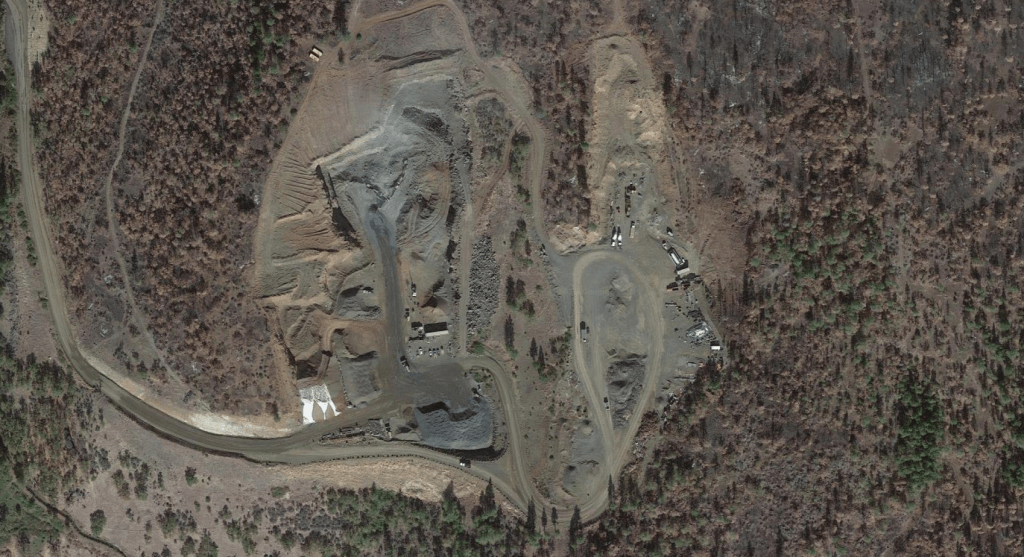Jackson County commissioners OK quarry expansion, despite opposition
Published 10:45 am Monday, January 8, 2024

- This image shows an aerial view of the Freel Ranch Quarry, 16568 Highway 62, between Eagle Point and Shady Cove.
The Jackson County Board of Commissioners has approved a rezoning request from a quarry operator near Eagle Point who wants to expand operations, despite recommendations from county planners and the Oregon Department of Fish and Wildlife that the request be denied.
A key concern of ODFW is the impact to deer and elk habitat from the mining, while county staffers and county planning commissioners cited ODFW’s opposition as figuring into their own recommendations for denial. It’s unclear if ODFW will appeal the decision to the Oregon Land Use Board of Appeals.
The current quarry, in operation since 2013, is at 16568 Highway 62, about halfway between Eagle Point and Shady Cove. It’s owned by Freel & Associates of Medford, which reports that it already has sold 1.3 million tons of aggregate from the site and predicts that the location could produce crushed rock for centuries to come in order to help build houses and infrastructure.
“The proposal is good planning because the County will need additional aggregate resources in the coming years,” the company stated in a Nov. 13 filing with the county’s planning department.
The 1,343-acre property currently has 155 of its acres zoned for aggregate removal, but the action by commissioners designates an additional 324 acres of the property — enough to take in an area a half-mile square — as a significant aggregate resource and rezones portions of the property from exclusive farm use to aggregate removal.
Commissioners voted unanimously after a public hearing on Wednesday to approve the ordinance allowing the changes. No members of the public spoke at the hearing, but a half-dozen concerned homeowners and an ODFW biologist spoke at a Nov. 15 board hearing on the matter, as did a hunters association representative and company representatives.
Commissioner Rick Dyer, who made the motion at the November hearing to move the project ahead, said on Wednesday he was satisfied that conditions placed on the company would protect wildlife habitat while providing rock for construction projects. Asked about a possible appeal, Dyer said he hoped that wouldn’t happen.
“I hope they understand and agree with us that both uses are important,” Dyer said, referring to wildlife habitat and rock quarrying. “We can have them exist together.”
Dyer said he spent a lot of time researching the issue, including listening to three hours of related planning commission proceedings.
“I just felt the mitigation, in my opinion, was adequate,” Dyer said.
The planning commission voted 3-2 on Oct. 12 to recommend denial, stating in its recommendation that it relied in part on a staff report that concluded that the proposal failed to meet a statewide planning goal concerning protection of natural resources, including deer and elk winter range. The staff report, in turn, noted ODFW’s opposition:
“Oregon Department of Fish and Wildlife (ODFW) as the leading local authority responsible for deer and elk habitat protection have recommended denial of the application,” the report stated.
Dan Ethridge, an assistant district wildlife biologist with ODFW, authored a six-page letter to the county outlining the agency’s position. He wrote that quarry operations were within an area designated as “especially sensitive winter range habitat.”
“The project includes mining activity that results in the direct loss of suitable wildlife habitat, which include direct and indirect impacts to wildlife, such as noise disturbance and displacement of wildlife during mining operations,” Ethridge stated. “ODFW is concerned that the conflicts to big game habitat due to the direct loss of habitat and indirect impacts associated with the mining operations have not been adequately evaluated.”
Ethridge also said that, ideally, mining would take place outside of designated winter range, and that there’s more than 500 other acres zoned aggregate resource in the northern part of the county that’s outside winter range. Winter range provides food and protection from predators.
Since 1980, there’s been a “steady decline” in the number of deer per mile in much of eastern Jackson County — from about 11 deer per mile to about eight per mile — demonstrating the need to protect habitat, according to Ethridge. He noted that quarry mining leaves behind steep rock cliffs and that oak habitat will take more than a century to regenerate. The company maintains that “benches” will be created in quarry pits.
Ethridge recommended that the company provide a thorough analysis of economic, social and environmental impacts, and that a conservation easement be put in place that would ensure third-party monitoring and enforcement of measures to restore the land.
Dan O’Connor, an attorney representing the company, flatly rejected an easement in an Oct. 14 email to Ethridge, a copy of which also was sent to the county:
“(A) conservation easement is just not an option for this property,” O’Connor stated.
Instead, O’Connor proposed that the company stockpile topsoil and place it on the floor of the quarry pit once mining is concluded. The pit floor would be replanted, too. He also proposed a payment of $40,000 per 40-acre pit, in order to fund ODFW winter range enhancement projects. The company also would continue to abide by seasonal operational restrictions, he said.
Dave Freel, of Freel & Associates, told commissioners at the November hearing that quarry operations are highly regulated and that the company would mine “one acre at a time in a maximum of 40-acre parcels at a time,” according to meeting minutes. Freel did not reply to inquiries from the Rogue Valley Times.
Also at the Nov. 15 hearing, six Eagle Point residents raised concerns about a range of issues, including oversight, dust, water quality, diminishing wildlife and loss of property value. Tyler Dungannon of the Oregon Hunters Association spoke about the value of wildlife and the importance of habitat, but took no stand for or against the quarry expansion.
Before new mining takes place, site plan approvals are needed from the county and the Oregon Department of Geology and Mineral Industries. Site plans detail how sites will be developed and typically show provisions for grading, landscaping, storm drainable, erosion control and utilities. The Oregon Department of Environmental Quality and the Oregon Department of Transportation also must grant approvals.
The company, in a filing with the county, stated that “ODFW has threatened to appeal any zoning approval to the Land Use Board of Appeals” unless the company agrees to an easement.
ODFW spokeswoman Meghan Dugan said on Thursday that the agency will review the county’s action.
“We are awaiting the county’s final decision language to review it before determining if any further actions may be warranted,” Dugan said.






